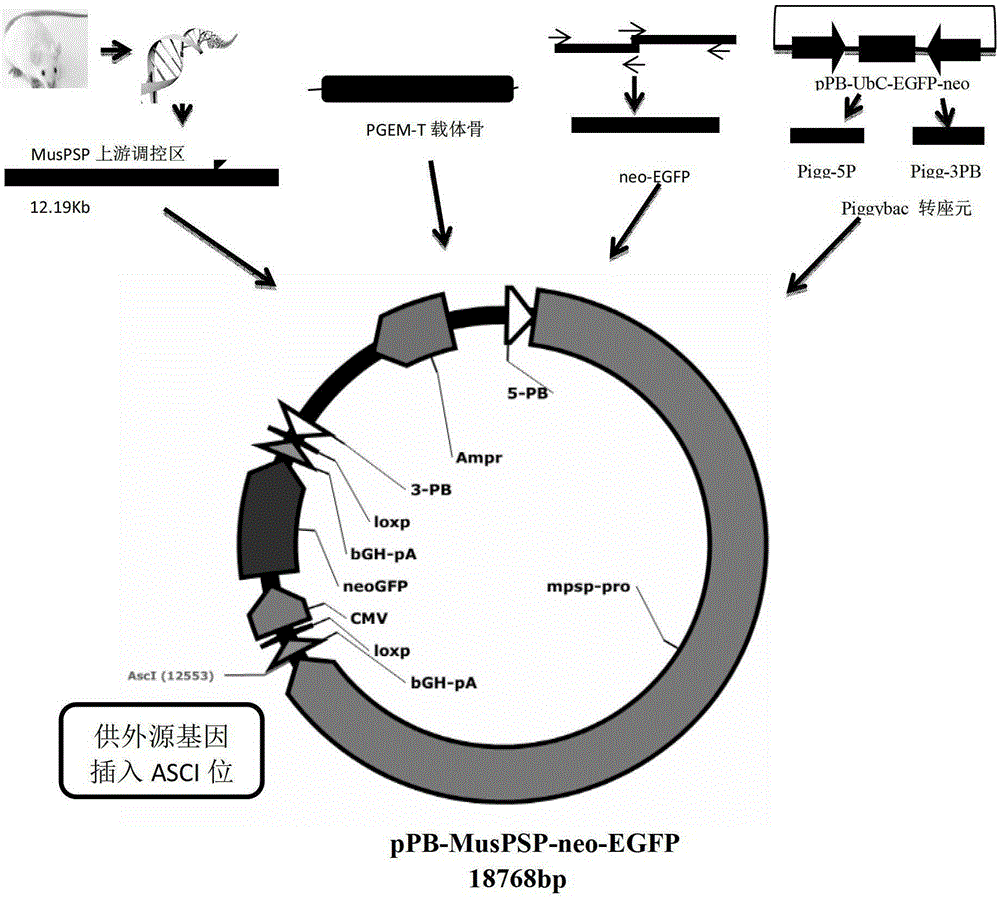Salivary gland tissue-specific transgene vector and its construction method
A tissue-specific, transgenic carrier technology, applied in the biological field, can solve the problems of incomplete regulatory elements, low expression of downstream protease genes, and no visible markers, and achieve good compatibility, simple identification, and high integration efficiency.
- Summary
- Abstract
- Description
- Claims
- Application Information
AI Technical Summary
Problems solved by technology
Method used
Image
Examples
Embodiment 1
[0041] The construction method of the transgene carrier specific for embodiment 1 salivary gland tissue
[0042] see image 3 , is a construction plan diagram of the salivary gland tissue-specific transgene vector of the present invention, comprising the following steps:
[0043] (1) Cloning of mouse parotid protein upstream regulatory region (PSP) (including parotid protein transfection recording start site and first intron)
[0044] The tail tissue samples of the FVB strain mice were taken, and the genomic DNA was extracted, followed by PCR amplification using the FVB mouse genomic DNA as a template, using KOD-FX polymerase (TOYOBO, Japan). Firstly, primers mpsp3497-F1 (SEQ ID NO: 1) and mpsp16390-R1 (SEQ ID NO: 2) were used for the first PCR amplification to obtain the upstream regulatory region of mouse parotid gland protein (-11503bp~+1390bp), and the results were as follows Figure 4 Shown in A; then adopt nested primer mPSP-3675-F2 (SEQIDNO: 3) and mPSP-15980-R2 (...
Embodiment 2
[0093] Example 2 Using the vector constructed in Example 1 to screen transgenic cells
[0094] Using conventional methods, the pPB-MusPSP-neo-EGFP vector constructed in Example 1 was used to transfect porcine fetal fibroblasts, and the results were observed after 14 days of screening with G418. The result is as Figure 13 As shown, the results show that the carrier greatly improves the efficiency of transgenic cell screening under the cooperation of auxiliary enzymes.
[0095] The results of flow cytometry analysis of its screening efficiency are as follows: Figure 14 shown, from Figure 14 It can be seen that as the molar ratio of mPB / PSP increases, the number of green fluorescent cells in groups Z1-Z6 increases first and then decreases. When the molar ratio of mPB / psp reaches 1 / 4, the positive rate of green fluorescent cells is the highest, reaching 22.16%, 1116 positive cell clones, which is 65.65 times of normal transfection linearized plasmid (control 1). When the mP...
PUM
 Login to View More
Login to View More Abstract
Description
Claims
Application Information
 Login to View More
Login to View More - R&D
- Intellectual Property
- Life Sciences
- Materials
- Tech Scout
- Unparalleled Data Quality
- Higher Quality Content
- 60% Fewer Hallucinations
Browse by: Latest US Patents, China's latest patents, Technical Efficacy Thesaurus, Application Domain, Technology Topic, Popular Technical Reports.
© 2025 PatSnap. All rights reserved.Legal|Privacy policy|Modern Slavery Act Transparency Statement|Sitemap|About US| Contact US: help@patsnap.com



